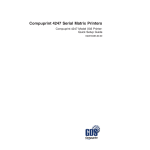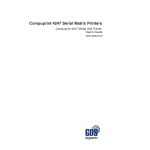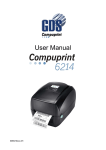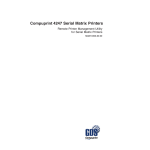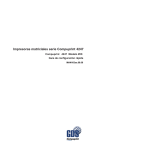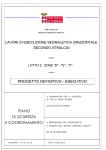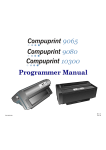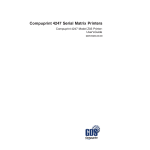Download Quick Setup Guide
Transcript
Compuprint 4247 Serial Matrix Printers Compuprint 4247 Model L03 Printer: Quick Setup Guide MAN10292.00.00 Before using this information and the product it supports, read the information in “Notices” on page 27. First edition (October 2011) This edition applies to the Compuprint 4247 L03 printer and to all subsequent releases and modifications until otherwise indicated in new edition. Internet Visit our home page: http://www.compuprint.com You can send comments by e-mail to : [email protected] or by mail to: Compuprint s.r.l. Via Lombardore 282 10040 Leinì (Turin) ITALY ii Quick Setup Guide Contents Safety and environmental notices . . . v Safety notices . . . . . . . . . . . . . Danger hazard level . . . . . . . . . . Caution hazard level . . . . . . . . . Attention notices . . . . . . . . . . . . Safety precautions . . . . . . . . . . . Electrical safety . . . . . . . . . . . Approved power cord and receptacle . . . . Electrical safety and portable power strip receptacles . . . . . . . . . . . . Connecting or disconnecting a communication port, a teleport, or an attachment connector . Servicing during an electrical storm . . . . . . . . v v v v . vi . vi . vi . vii . vii . vii Setting up your printer . . . . . . . . 1 Step 1 – Unpacking Your Printer. . . Printer Parts . . . . . . . . Choosing a Suitable Location . . . Removing the Shipment Locks . . Installing the operator panel overlay . . . . . . . . . . . . . . . . . . . . . . . . . 1 2 3 4 4 Step 2 - Installing the Ribbon Cartridge . Replacing the Ribbon Cartridge . . . Step 3 – Installing the Controller Board . Handling the Controller Board . . . Inserting the Controller Board . . . Step 4 – Starting the Printer . . . . . Host Computer Connection . . . . Software Driver Selection . . . . . Power Connection . . . . . . . Step 5 – Selecting the Display Language . Step 6 – Loading Fanfold Paper . . . Printing a Default Configuration Sheet . Configuring the Printer . . . . . Maintenance & Troubleshooting . . . Cleaning the Printer . . . . . . Printing the Self Test . . . . . . LCD Display Messages . . . . . . Error Messages . . . . . . . . Options. . . . . . . . . . . . . . . . . . . . . . . . . . . . . . . . . . . . . . . . . . . . . . . . . . . . . . . . . . . . . . . . . . . . . . . . . . . . . . . . . . . . . . . . 5 7 8 8 8 11 11 12 12 14 15 20 20 21 21 21 22 24 25 Notices . . . . . . . . . . . . . . 27 iii iv Quick Setup Guide Safety and environmental notices Safety notices There are two levels of safety notices: Danger and Cautions. Danger hazard level The word Danger indicates the presence of a hazard that has the potential of causing death or serious personal injury. Most DANGER notices are numbered <1-1>, <1-2>, and so forth where they appear in the text of this manual. Example of a Danger notice: DANGER <1-10> Hazardous voltages are present. Do not touch the pins or sockets of the power receptacle. Caution hazard level The word Caution indicates the presence of a hazard that has the potential of causing moderate or minor personal injury. Most CAUTION notices are numbered <2-1>, <2-2>, and so forth where they appear in the text of this manual. Example of a Caution notice: ! CAUTION: <2-22> Carefully follow all cleaning instructions, using only the materials and solutions recommended. Attention notices The word Attention calls attention to the possibility of damage to a program, device, system, or data. Attention notices are not numbered. Examples of an Attention notice: Attention: The above openings must always be protected with their covers. Do not touch inside and do not insert any object into these openings or into the gears. v Safety precautions Never remove any printer cover except to install a printer accessory as expressly described in this manual. The following areas of the printer should be covered for safety reasons: Large Rear Cover HC0I0001 Small Rear Cover Attention: The above openings must always be protected with their covers. Do not touch inside and do not insert any object into these openings or into the gears. Electrical safety This printer is inspected and listed by recognized national testing laboratories, such as Underwriters Laboratories, Inc. (UL) in the U.S.A. and Canadian Standards Association (CSA) in Canada. Listing of a product by a national testing laboratory indicates that the product is designed and manufactured in accordance with national requirements intended to minimize safety hazards. This equipment meets a very high standard of safety in design and manufacture. Remember, however, that this product operates under conditions of high electrical potentials and heat generation, both of which are functionally necessary. Because the paper used in the printer can burn, you should take normal precautions to prevent fire. These precautions include common-sense measures, such as keeping potentially combustible materials (for example, curtains and chemicals) away from the printer, providing adequate ventilation and cooling, limiting unattended operation, and having trained personnel available and assigned to the printer. Approved power cord and receptacle DANGER <1-11> Your country may require an approved power cord and plug. Ensure that you have the correct power cord and plug. Use this cord and plug only with an approved, correctly-installed power receptacle. vi Quick Setup Guide Electrical safety and portable power strip receptacles Extension cords DANGER DANGER <1-1> Do not use an extension power-cord. The customer must supply the correct electrical outlet which must meet the requirements stated under “Printer Specifications” in the User's Guide. Portable power strip receptacles (temporary power taps) Portable power strip receptacles (referred to as “temporary power taps” by the National Electrical Code) may be used if they are fully approved in the customer's geographic location. It is the customer's responsibility to supply a fully approved “temporary power tap”, if one is to be used. Connecting or disconnecting a communication port, a teleport, or an attachment connector DANGER <1-14> Switch off printer power and unplug the printer power cord before connecting or disconnecting a communication port, a teleport, or other attachment connector. Servicing during an electrical storm DANGER <1-13> Do not connect or disconnect a communication port, a teleport, or any other connector during an electrical storm. Safety and environmental notices vii viii Quick Setup Guide Setting up your printer To set up your printer, follow these steps. Step 1 – Unpacking Your Printer The following items are included in the carton: Contact your point of purchase seller if any items are missing. Figure 1. Carton Contents The Controller Board includes the printer software program (firmware) and the interface connectors to the host system. 1 Printer Parts Figure 2. Printer Parts: Front and Rear View 2 Quick Setup Guide Choosing a Suitable Location CAUTION: The 4247 printer weighs 21 kg (46 lbs). Two persons are required to lift it. Consider the following points when you choose the location for your printer: v The distance between the printer and the host computer must not exceed the length of the interface cable. The location must be sturdy, horizontal and stable v Your printer must not be exposed to direct sunlight, extreme heat, cold, dust or humidity (see “Printer Specifications” in the User's Guide you find on the CD-Rom) v You need a power outlet compatible with the plug of the printer's power cord. v For best continuous forms stacking, the forms should be stacked on the floor or on a surface below the base of the printer. v For successful forms parking, the input forms stack must always be lower than the base of the printer. v There must be sufficient clearances on all sides for easy operation. The required space is shown in the following figure: 80 cm 31.5 in. 1 39 00 . 4 cm in m 20 c 7.9 in cm 0 in 1 0 .4 39 Hc0i0005 m 20 c in 7.9 Figure 3. Printer showing dimensions in inches and centimeters. Setting up your printer 3 Removing the Shipment Locks Open all the printer covers and make sure that you remove all the shipment locks from the printer. Figure 4. Printer showing location of the Shipment Locks The following sections describe how to install the Operator Panel Overlay, the ribbon cartridge, and the Controller Board. Installing the operator panel overlay Figure 5. Operator Panel 1. Remove the paper backing from the back of the overlay. 2. Carefully align the overlay ensuring free movement of the operator panel keys. 3. Press the overlay in place starting at the bottom , and continue working upwards until the overlay is pressed into place. 4 Quick Setup Guide Step 2 - Installing the Ribbon Cartridge 1. Find the ribbon cartridge among the accessories. Ribbon Guide HC0I0007 Ribbon Winding Knob Cartridge Pins Figure 6. Ribbon Cartridge 2. Open the top cover using the small handles on either side of the top cover. 3. Slide the print head to the center of the printer. Before installing the ribbon cartridge turn the ribbon-winding knob in the arrow direction (located on the cartridge) to take up slack in the ribbon. To avoid damage to the ribbon, do not turn the winding knob in the wrong direction. HC0I0008 4. Align the cartridge pins with the locking grooves on the left and right cartridge supports. Figure 7. Aligning the right and left cartridge pins with the locking points. Setting up your printer 5 5. Slide and insert the ribbon guide between the print head and the ribbon guide mask holding it perpendicular to the print head. HC0I0030 Make sure that the ribbon is inserted correctly between the print head and the ribbon guide mask. Figure 8. Print head and ribbon guide mask showing correct positioning of the ribbon. 6. Turn the ribbon-winding knob in the arrow direction (located on the cartridge) to take up slack in the ribbon. 7. Push the cartridge down gently until it clips into place at the locking points. 8. Turn the ribbon-winding knob again in the direction of the arrow to take up slack in the ribbon. 9. To ensure that the ribbon guide runs freely along the ribbon, manually move the print head horizontally. 10. Close the cover and turn on the printer. 6 Quick Setup Guide Replacing the Ribbon Cartridge 1. Make sure that the printer is turned off for at least 15 minutes. CAUTION: <2-51> The printhead may get hot during operation. Be careful when removing or replacing the ribbon. 2. Open the top printer cover. 3. Slide the ribbon guide out of the print head. 4. Remove the used ribbon cartridge by lifting it up. Now, you are ready to install the new ribbon cartridge. Setting up your printer 7 Step 3 – Installing the Controller Board The 4247 printer arrived with the Controller Board that you ordered. You must install the Controller Board (received with the printer) into the proper slot in the back of the printer before it can be used. Handling the Controller Board Attention: Do not remove the Controller Board from the protective package until instructed to do so. Static electricity, though harmless to you, can damage sensitive Controller Board components. Use the information in this section to avoid damaging a Controller Board. v Limit your movement. Your movement can create static electricity that, when released to the Controller Board, can damage the electronic components on the Controller Board. Sliding your foot across carpeting is an example of how you create unwanted static electricity. v Handle the Controller Board only by the edges and prevent others from making direct contact with it. v Before removing the Controller Board from the protective package, ground the package to exposed metal at the back of the printer. This will release any static charge that may have developed on the package or on your body. Hold the package against the metal for at least two seconds. v When you are instructed, remove the Controller Board and install it directly into the Controller Board slot without setting it down. If you have removed the Controller Board from the protective package and cannot immediately insert it in the printer, place the protective package on a flat surface, and set the Controller Board on top of the protective package. Inserting the Controller Board Attention: Ensure that the printer is powered off before installing or removing the Controller Board. If the Controller Board is installed while the printer is powered on, the controller will not synchronize with the printer mechanism board. Unpredictable printer behavior will result. Perform the following steps to install the Controller Board: 1. Ensure that the printer is powered off. Installing the Controller Board with the printer power on will result in unpredictable printer behavior. 2. Use the screwdriver that came in the Controller Board box to remove the metal plate on the back of the printer by unscrewing the two screws. Note: Save the two screws and the metal plate for reuse if the Controller Board is removed. 8 Quick Setup Guide HC0I0034 Figure 9. Removing the two screws on the metal plate. 3. Use the information under “Handling the Controller Board” on page 8 as you remove the Controller Board from its shipping box and from the protective package. HC0I0035 4. Align the left and right sides of the Controller Board with the guides in the printer and slide it into the slot. Figure 10. Sliding the board in the slot. 5. Gently push the Controller Board into the printer until it is seated in the connector inside the printer. The Controller Board is correctly seated in the printer when the Controller Board metal plate is aligned with the back profile of the slot. Setting up your printer 9 HC0I0036 6. Attach the Controller Board with the two screws using the screwdriver that came in the Controller Board box. Figure 11. Attaching the Controller Board. 10 Quick Setup Guide Step 4 – Starting the Printer Host Computer Connection This printer can be connected to your host computer with the interfaces available on the Controller Board you have found in the printer box and installed on the rear of the printer. There are two types of Controller Boards: 1. Controller Board with a bidirectional IEEE1284 parallel interface and Ethernet 10/100 BaseT LAN interface. 2. Controller Board with a bidirectional IEEE1284 parallel interface, Serial RS-232/C 9-pin interface and USB 2.0 interface. DANGER <1-14> Switch off printer power and unplug the printer power cord before connecting or disconnecting a communication port, a teleport, or other attachment connector. Insert the host computer cable(s) into the back of the printer as shown below. Serial Interface Ethernet Interface Controller Board with parallel interface and Ethernet 10/100 BaseT LAN interface. Parallel Interface HC0I0038 Hc0I0037 Parallel Interface USB Interface Controller Board with parallel interface, Serial interface, and USB interface. Setting up your printer 11 Software Driver Selection At this point it is necessary to configure your printer for your application package. The installation procedures depend upon the host environment. In a WINDOWS environment the printer supports the Plug & Play feature. Power Connection DANGER <1-11> Your country may require an approved power cord and plug. Ensure that you have the correct power cord and plug. Use this cord and plug only with an approved, correctly-installed power receptacle. 1. Make sure the power outlet is near the printer location and easily accessible. 2. Make sure that the power switch is in 0 position (OFF). 3. Insert the power cable plug into the printer connector and the other power cable end into a convenient outlet. 2 HC0I0014 1 Figure 12. Inserting the power cable plug into the printer connector and the other power cable end into a convenient outlet. 12 Quick Setup Guide HC0I0015 4. Turn the printer on, press the power switch in the I position (ON). Figure 13. Power switch in the I position (ON). Attention: If, for any reason, the Controller Board was not correctly installed in the printer, the printer will not work and the following audio/visual symptoms will occur: v The buzzer sounds continuously v The Operator Panel display is partially filled with solid black boxes v The Operator Panel LEDs are all lit. If this is the case, power off the printer, re-seat the Controller Board, and power the printer on again. Setting up your printer 13 Step 5 – Selecting the Display Language The display messages for this printer can be displayed in eleven different languages (the default language is English). To select the language you want, proceed as follows: 1. Press the PROGRAM key and keep it pressed while powering on the printer until the following message is displayed: RELEASE KEY 2. When you release the PROGRAM key, the display shows the name of the printer followed by: PRINT OUT? NO 3. Press the key to enter the menu. The first menu item is displayed: EMUL. OPTIONS 4. Press the key until the language first level function is displayed: FUNCTIONS 5. Press the key to pass to the second level functions BUZZER YES 6. Press the key until the menu language is displayed: MENU ENGLISH key to scroll the menu languages. When the desired language is 7. Press the displayed, press the PROGRAM key to select it. The printer exits the menu. From now on the display messages appear in the selected language. 14 Quick Setup Guide Step 6 – Loading Fanfold Paper This sequence describes how to load the fanfold paper with the Front1 push tractor (default). For the other paper paths please see the User's Guide you find on the CD-Rom. 1. Turn the printer on. 2. Open the Push tractors cover turning it upwards and lay it on the top of the printer. HC0I0016 Figure 14. Opening the Push tractors. Hc0I0018 3. Unlock the sprockets of the Front1 push tractor moving the sprocket levers to the down position. Figure 15. Unlocking the sprockets on the Front1 push tractor. Setting up your printer 15 HC0I0019 4. Space the paper guides along the tractor bar. Open the left and right sprocket covers. Figure 16. Opening the left and right sprocket covers. 16 Quick Setup Guide 5. Hold the fanfold paper in front of the sprockets and insert the paper perforation on the left sprocket pins and close the left sprocket cover. Figure 17. Inserting the paper perforation on the left sprocket pins. 6. Insert the paper on the right sprocket pins. HC0I0022 Figure 18. Inserting the paper on the right sprocket pins. Setting up your printer 17 7. Match the left sprocket for the first printing position, that is the left margin must match the ninth mark on the printer cabinet. Note: Aligning the left-hand edge of the paper past the 22nd spacer on the printer cabinet will cause the paper to be misaligned with the Paper Load Sensor resulting in a '001 End of Forms' error. 9 1 2 3 4 5 6 7 8 HC0I0023 Figure 19. Matching the left sprocket for the first printing position. 8. Adjust the right sprocket gently to remove slack from the paper. Lock the left and right sprockets moving the sprocket levers to the up position. HC0I0025 Figure 20. Adjusting the right sprocket gently to remove slack from the paper. 9. Close the Push tractors cover. 18 Quick Setup Guide HC0I0026 Figure 21. Closing the Push tractors cover. 10. Press the ON LINE key to take the printer OFF LINE. 11. Press the LOAD/FF key to load the paper into the printer. 12. Press the ON LINE key to put the printer ON LINE. Setting up your printer 19 Printing a Default Configuration Sheet We recommend that you now print your printer configuration defaults. Save this printout for future reference. You can create a printout of the printer configuration by following these steps: 1. Press the ON LINE key to take the printer OFF LINE. 2. Press the PROGRAM key. The printer displays: PRINT OUT? NO 3. Press the key. PRINT OUT? YES The “PROGRAM SETUP PRINTOUT” prints. 4. Press the key until CONFIG MENU NO is displayed. key to display 5. Press the CONFIG MENU YES 6. Press the key PRINTOUT NO is displayed. key. The “CONFIGURATION SETUP” prints. 7. Press the 8. Press the PROGRAM key. 9. Press the TEAR key and tear off the printout at the perforation. Configuring the Printer See the 4247-L03 Printer: User's Guide on the CD-ROM for information about how to make and save printer configuration setting changes. 20 Quick Setup Guide Maintenance & Troubleshooting Cleaning the Printer CAUTION: <2-22> Carefully follow all cleaning instructions, using only the materials and solutions recommended. Periodic cleaning will help keep your printer in top condition so that it will always provide optimal performance. Before you clean the printer: 1. Turn off the printer. 2. Unplug the power cord. 3. Wait at least 15 minutes for the printhead to cool before starting this procedure. Cleaning inside the printer Every few months, use a soft brush and a vacuum cleaner to remove dust, ribbon lint, and pieces of paper. Remove the ribbon cartridge to prevent the ribbon from going into the vacuum cleaner. Vacuum any dust from around the printhead and in the printer cavity. Attention: Do not allow any staples, paper clips, or small metal pieces to fall inside the printer. Cleaning the outside covers Clean the outside of the printer with a damp cloth and mild soap. Do not use any spray-type or chemical cleaners anywhere on your printer. Do not put any liquids or spray near the air vents. For stubborn ink stains on the cover, use a commercial mechanic's hand cleaner. Do not use an abrasive cloth, alcohol, paint thinner, or similar agents because they may cause discoloration or scratching. Printing the Self Test Proceed as follows: 1. Keep the ON LINE key pressed while powering on the printer until the display shows RELEASE KEY. 2. When you release the key, the printer starts the self-test printout. 3. To stop the self-test printing, press the ON LINE key again. The printer is offline. Setting up your printer 21 LCD Display Messages Table 1. Display Messages ALTERNATE This message appears to indicate that the Alternate functions of the operator panel keys have been selected pressing the ALTERNATE key. BUSY M1 This message appears to indicate that the printer is printing. It is busy. COVER OPEN When the printer cover is not closed correctly, the buzzer sounds and the display shows alternately these two messages. Close the printer cover. CLOSE COVER EJECTING The printer is ejecting the paper out of the printer. INITIALIZING LAN This message is displayed when the LAN is reset (only if the LAN interface board is installed). LOAD FRONT1 These messages are displayed, according to the installed devices, when the corresponding paper path is out of paper. LOAD FRONT2 LOCKED MENU When the access to the Printer Setups has been locked at the power on, the printer displays this message. MACRO CHANGING The macro has been changed and the printer is updating the settings. MICRO FEED DOWN The paper is fed in microsteps downwards when pressing the ↓ arrow key. MICRO FEED UP The paper is fed in microsteps forwards when pressing the ↑ arrow key. OPER. INTERRUPTED This message is displayed if the ALTERNATE key has been pressed to interrupt a park procedure. PARKING The printer is parking the fanfold paper. PATH CHANGING The path has been changed and the printer is updating the settings. PRESS A KEY The NVM has been changed. Press any key to set the printer. NVM CHANGED RELEASE KEY This message is displayed when you can release the PROGRAM key in the Self-test selection or in the Power-on Configuration procedure. REMOTE CONTROL This message is displayed when the printer operates from remote control (only if the LAN interface board is installed). RESET & BREAK The printer received a reset and break command via interface. SELF TEST Printing the self-test page. TEAR IF NECESS. These messages are displayed when the printer receives a paper parking command and the TEAR NO item is selected for the tear-off function. Tear off the fanfold at a perforation before it enters the tractors and press the PARK key to eject it out the top of the printer. EJECT PAPER TEAR IF NECESS. PARK PAPER TEAR OFF PAPER EJECT PAPER TEAR OFF PAPER PARK PAPER 22 Quick Setup Guide These messages are displayed when the printer receives a paper parking command. Tear off the fanfold paper if necessary and then press the PARK key to park the paper. These messages are displayed when the printer receives a paper ejecting command (TEAR NO item has been selected for the tear-off function) but was not able to execute it, because the paper to be ejected is longer than 18 inch. Tear off the fanfold paper and then press the PARK key to eject the paper. These messages are displayed when the printer has received a paper parking command but was not able to execute it, because the paper to be parked is longer than 18 inch. Tear off the fanfold paper and then press the PARK key to park the paper. Table 1. Display Messages (continued) UNLOCKED MENU When the access to the Printer Setups has been unlocked at the power on, the printer displays this message. Setting up your printer 23 Error Messages When an error condition occurs: v The printer is disabled v The first message on the display indicates the error, while the second message gives more details concerning the error conditions. Press the ON LINE key to reset the error condition. If the error condition returns after performing the suggest solutions, call for service. Table 2. Error Messages A.G.A NOT OPER ADJUST THE GAP BUFFER OVERFLOW CHARACTER LOST DATA SET OFF NVM CHANGE Indication: The automatic gap adjustment (A.G.A) is not operating. Solution: Press the ON LINE key to reset the error condition. Adjust the print head gap to a fixed distance. Select the print head fixed gap adjustment function in the ‘Program Menu’. See the User's Guide you find on the CD-Rom. Indication: Buffer overflow. Solution: Turn the printer off and on again, or press the PROGRAM and ON LINE key successively to clear the buffer. Check the printer SERIAL INTERFACE settings. See the User's Guide you find on the CD-Rom. Indication: The DSR Signal is not connected to the printer and is not ready for data transfer (if the serial interface is selected). Solution: Press the ON LINE key to reset the error condition. Check the printer SERIAL INTERFACE settings. See the User's Guide you find on the CD-Rom. Indication: If this error is displayed during the printer power on, an NVM error condition occurs. Solution: Turn the printer off and on again. If the problem is not solved call Service. Indication: A paper jam occurs in a paper path. Solution: Check all the paper paths and press the ON LINE key. Indication: Printhead movement is blocked. Solution: Check ribbon cartridge installation and for other possible blockages to the Printhead carriage. Indication: The ribbon of the cartridge is blocked. Solution: Check the ribbon. Press the ON LINE key to reset the error condition. REMOVE PAPER PAPER JAM CHECK ALL PATHS PRINT INTEGRITY RIBBON BLOCKED CHECK RIBBON 24 Quick Setup Guide Options Option Printer Stand Description For large fanfold paper quantity and dual fanfold handling. Front2 Push Tractor The Front2 push tractor is useful for handling a 2nd fanfold. Controller Board There are two Controller Board options: 1. Allows a host connection to parallel, serial, and USB 2.0 interfaces. 2. Allows a host connection to parallel and Ethernet 10/100 BaseT LAN network interfaces. Setting up your printer 25 26 Quick Setup Guide Notices Thanks for choosing the 4247 printer. Your printer is a reliable working equipment that will be very useful in your daily job. Our printers have been designed to be compact and respectful of the work environment. They offer a wide range of features and multiple functions that confirm the high technological level reached by the printers with Compuprint brand. To maintain these printing performances unchanged in the long run, Compuprint has developed specific consumables for each printer type that assure an excellent operation with high printing quality level reliability. Compuprint srl recommends to use only its original consumables with original packaging (identified by its holographic label). In this way, a proper use of the printer at quality level stated in the product characteristics can be assured. All typical usage problems related to not certified consumables may be avoided, such as an overall quality print level degradation and, often, the reduction of the product life due to the fact that the proper working conditions for the print heads and other printer parts are not assured. Moreover, Compuprint does not only certify its consumables in terms of working conditions but also carefully controls their compliance with the international standard rules concerning: • • • no cancerous materials; no flammability of the plastic materials; other standards Compuprint advises the customers not to use products for which the compliance to this safety rules are not warranted. Finally seek your dealer or contact a Compuprint office and be sure that are provided you the original consumables. FFC Notes This equipment has been tested and found to comply with the limits for a Class A digital device, pursuant to Part 15 of the FCC Rules. These limits are designed to provide reasonable protection against harmful interference when the equipment is operated in a commercial environment. This equipment generates, uses, and can radiate radio frequency energy and, if not installed and used in accordance with the instruction manual, may cause harmful interference to radio communications. Operation of this equipment in a residential area is likely to cause harmful interference in which case the user will be required to correct the interference at his own expense. Properly shielded and grounded cables and connectors must be used in order to meet FCC emission limits. Compuprint is not responsible for any radio or television interference caused by using other than recommended cables and connectors or by unauthorized changes or modifications to this equipment. Unauthorized changes or modifications could void the user’s authority to operate the equipment. This device complies with Part 15 of the FCC Rules. Operation is subject to the following two conditions: (1) this device may not cause harmful interference, and (2) this device must accept any interference received, including interference that may cause undesired operation. 27 European Union (EU) Conformity Statement Compuprint srl declares that this product is in compliance with the essential requirements and other relevant provisions of Directive 2006/95/EC, 2004/108/EC. Per the applicable requirements of EU directive 98/37/EC (“machines”) sound pressure of the above product (measured according to EN27779) does not exceed 70dBA. This product has been tested and found to comply with the limits for Class A Information Technology Equipment according to European standard EN 55022. The limits for Class A equipment were derived for commercial and industrial environments to provide reasonable protection against interference with licensed communication devices. Important This is a Class A product. In a domestic environment this product may cause radio interference in which case the user may be required to take adequate measures. Properly shielded and grounded cables and connectors must be used in order to reduce the potential for causing interference to radio and TV communications and to other electrical or electronic equipment. Compuprint srl cannot accept responsibility for any interference caused by using other than recommended cables and connectors. Industry Canada Compliance Statement This Class A digital apparatus complies with Canadian ICES-003. Cet appareil numérique de la classe A est conform à la norme NMB-003 du Canada. Statement for CISPR 22 Edition 2 Compliance Attention: This is a Class A product. In a domestic environment this product may cause radio interference in which case the user may be required to take adequate measures. User Information according to European Directive 2002/95/EC and 2003/108/EC This unit must be recycled or discarded according to applicable local and national regulations. The symbol shown on the left, applied to the product or on its packing, indicates that, at end of life, the product is not to be thrown away, or disposed as unsorted municipal waste, but separately collected. Compuprint srl encourages owners of information technology (IT) equipment to responsibly recycle their equipment when it is no longer needed. Customer that needs to dispose this equipment must contact the produce and follow the collection framework available locally for the return, recycling and recovery of WEEE. Customer participation to the separate collection is important to minimize any potential effects on the environment and human health, due to the potential presence of hazardous substances in the equipment, and aids the reuse and recycle of the materials by which the equipment is made. Uncorrect disposal of the product by the customer will be punished according to the local regulations and Laws. 28 Quick Setup Guide MAN10292.00.00 Printed in Italy MAN10292.00.00






































